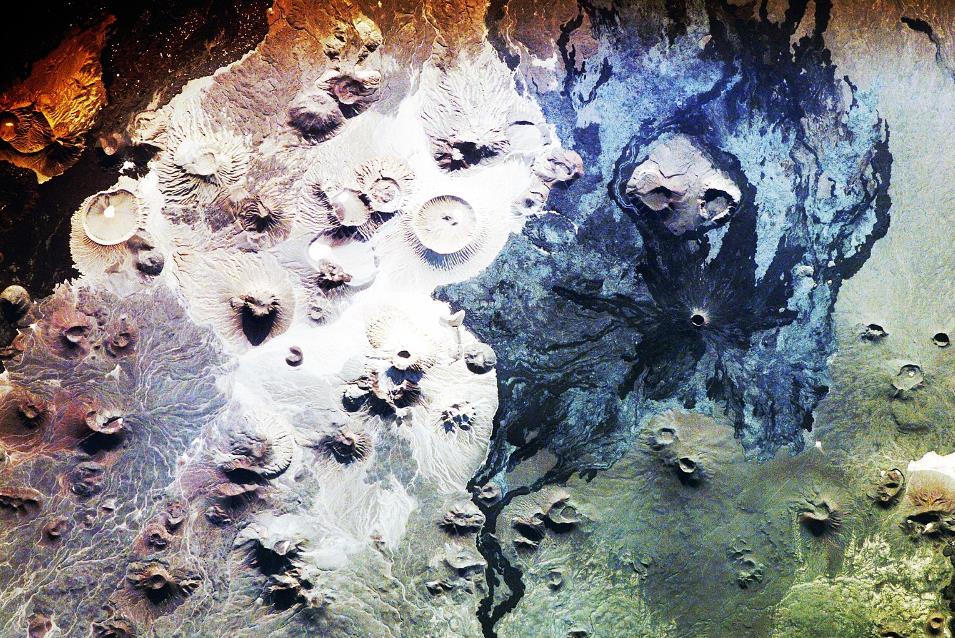Harrat Khaybar is an enigmatic structure often dubbed the “gates of hell,”. It is not only a name that was chosen for impact. Harrat Khaybar is a volcanic area located north of Medina in the Hejaz region, of Saudi Arabia. It has an area of almost 12,000 km2 in the desert region of Saudi Arabia and depicts the ferocious eruptions that sculpted the country’s rough landscape over millions of years.
The scars on the landscape are the remains of volcanic activity stretching back over five million years, with the latest eruptions occurring between 600 and 700 AD, according to NASA. Despite its turbulent history, this harsh environment surprisingly exposes signs of human settlement amidst the volcanic chaos. The White Mountains of Harrat Khaybar, Jabal Abyad, and Jabal Bayda get their light color from the comendite. Jabal Abyad, at 2,093 meters, is Saudi Arabia’s tallest volcano.
The barren plain is dotted with enigmatic round stone structures reminiscent of those found in Europe, hinting at a lost chapter in human history. These formations remained a mystery until satellite images revealed their actual nature as Neolithic settlement ruins. Today, specialists marvel at the Khaybar area’s distinctiveness, which is defined by its vast variety of structures that have survived surprisingly well in the desert climate. The European Geosciences Union (EGU) described it as a “full prehistoric landscape trapped in time” in 2018.
Among the nearly 400 constructions going back up to 9,000 years, volcanic stones were cleverly used to construct communities, fences, and interesting formations such as “kites” and “gates.” The so-called “desert kites,” thought to be prehistoric animal traps, raise a perplexing question: were they just hunting equipment or early attempts at animal domestication? Similarly, the mysterious “gates,” located on the slopes of a volcanic dome, defy simple explanations. These stone constructions, which resemble field gates from above, are among the earliest man-made formations in the area. However, their purpose remains unknown, provoking suspicion among scholars.
David Kennedy, a lecturer at the University of Western Australia, described their remarkable contrast to ordinary human settlements or animal traps as an everlasting mystery. Despite intensive inquiry, no apparent function has emerged for these mysterious gates, perplexing researchers. While the intent of these structures remains unknown, insights into ancient life in this volatile environment provide interesting possibilities.
According to Dr. Hugh Thomas, a lecturer in archaeology at the University of Sydney, during the Neolithic period, Harrat Khaybar was far from the desolate desert we see today. It most likely supported robust communities and abundant fauna. Harrat Khaybar’s lava fields include evidence of early human occupation. There have been studies on the remains of Neolithic human groups, such as habitations, fences, and funeral constructions made of volcanic stone.
The search for explanations has pushed researchers to use unusual tactics, such as using Google Earth, to discover and study these mysterious formations. Despite difficulties in accessing the region directly, satellite imagery has been important in revealing Saudi Arabia’s vast archaeological legacy. As we continue to explore the mysteries of Harrat Khaybar, we see evidence of ancient civilizations’ persistence and the appeal of the unknown.
This mountainous environment, previously dominated by explosive eruptions, contains a treasure mine of history waiting to be unearthed. The Umm Jirsan lava tube is located within the lava field and measures 1,481 meters in length. It is divided into three sections and includes two fragments of the collapsed ceiling. It is Saudi Arabia’s longest lava tube network.
Reference: Wikipedia
